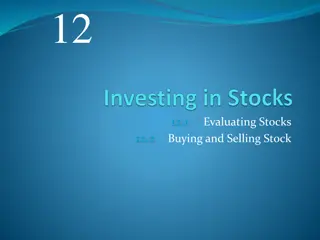Understanding Fundamental Analysis in Stock Market Investing
Fundamental analysis blends economic, industry, and company evaluations to determine a stock's fair value and future potential. By considering macroeconomic factors like GDP, savings, inflation, interest rates, and budget impacts, investors can make informed decisions in the stock market.
Download Presentation

Please find below an Image/Link to download the presentation.
The content on the website is provided AS IS for your information and personal use only. It may not be sold, licensed, or shared on other websites without obtaining consent from the author. Download presentation by click this link. If you encounter any issues during the download, it is possible that the publisher has removed the file from their server.
E N D
Presentation Transcript
Meaning of Fundamental Analysis It is a combination of economic, industry and company analyses to obtain a stock s current fair value and predict its future value. Also called top-down approach or EIC(Economic, Industry and Company) analysis.
Economy Stock value Industry Company
Economic Analysis Economic Analysis is a study of the general economic factors that go into an evaluation of a security s value. When economic activity is low , stock prices are low, and when the economic activity is high, stock prices are high.
Macroeconomic factors Gross Domestic Product It represents the aggregate monetary value of the goods and services produced in the economy during the specified period. GDP = Consumption + Investment + Exports Imports High GDP High return Low GDP Low return & decline in economy.
Savings and Investment Growth in savings leads to more investments. High capital Investment leads to more production, more demand and supply, better prices in the future, higher business profit and a positive outlook for the stock market.
Inflation Inflation is a situation where too much money is chasing too few goods. It leads to increase in the price of goods and services. It results in: High raw material cost Non-availability of cheap credit Low earnings
Interest rates The base rate of banks affects the cost of borrowed funds. The base rate is the minimum rate of interest at which banks lend to anyone. It is influenced by RBI s bank rate, repo rate and CRR.
Budget Budget provides a detailed account of government revenues and expenditures. Deficit Budget Increase in inflation, affect cost of production Surplus Budget Deflation Balanced Budget Highly favorable to stock market
Fiscal Deficit Fiscal Deficit = Government s Total receipts(excluding borrowing) - Total expenditure.
Tax Structure The business community eagerly awaits the statement from the government regarding the tax policy. Concessions and incentives given to a particular industry encourage investment in that particular industry.
Balance of Payments(BOP) It is the record of a country s money receipts from abroad and payments to foreign countries. BOP = Receipts Payments Favourable BOP has a positive effect on the stock market.
Foreign Direct Investment(FDI) FDI in India is a major monetary source for economic development in India. Foreign companies invest directly in fast growing private Indian businesses to take benefit of cheaper wages and changing business environment of India.
Investment by Foreign Institutional Investors(FIIs) A foreign institutional investor (FII) is an investor or investment fund registered in a country outside of the one in which it is investing. Institutional investors most notably include hedge funds, insurance companies, pension funds and mutual funds.
International Economic conditions Worldwide economies are not independent but interdependent. The boom or depression in one company affects other countries and the stock market.
Business Cycle and Investor Psychology
Monsoon and Agriculture In spite of technological advancements, Indian agriculture still depends heavily on the monsoon. Good monsoon are a boon for agriculture. Agriculture is directly or indirectly linked to many industries.
Favourable Monsoon Unfavourable or failure of Monsoon High demand for hybrid seeds, fertilizers, farm equipment,etc Low demand for hybrid seeds, fertilizers, farm equipment, etc. Bumper crops Failure of harvest High rural disposable income Less rural disposable income High rural demand for consumer goods, cars, etc Less rural demand for consumer goods, cars, etc Raw naterials























